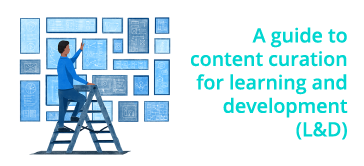What can content curators learn from art curators?

In an earlier stage of my work life I was a full-time creative (now it's just a part-time activity). One of my roles during this time was as a freelance contemporary art curator. In this post I thought it could be interesting to think about an art curator and what a content curator might learn from them when it comes to learning design.
In an earlier stage of my work life I was a full-time creative (now it's just a part-time activity). One of my roles during this time was as a freelance contemporary art curator. In this post I thought it could be interesting to think about an art curator and what a content curator might learn from them when it comes to learning design.
What does a curator do?
A curator creates new ideas by associating art works together in new ways. Generally speaking, you might think of art curating as comprising five activities.
1. Choosing works
The core of a curator’s job is choosing works for an exhibition. They work from a theme that might be inspired by an idea or an existing work. This process of selecting works is not about the quality of the work itself but about how it fits together with the other pieces in the show.
2. Placement
Most curation activities result in an exhibition in space, and a key skill in associating works effectively is in designing how the area within the gallery is arranged. Design and placement means making sure the individual works are set up in a way that maximises their impact. The parallel process in learning design is the sequencing of content and resources.
3. Providing a context
Most exhibitions include a catalogue – a list of the works in the show – usually with one or more essays about the show’s themes or ideas. The catalogue acts as a record of the event but additionally the essays provide a context and background for the ideas.
4. Logistics
The day-to-day work of curating is "making it happening", which means things like arranging contracts, organising shipping and managing budgets. For a content curator these logistics are the nuts-and-bolts activities like adding resources to a database.
5. Expanding activities
Even with most traditional exhibitions in a gallery it’s not just about collecting items for display. The exhibition can be expanded in several different ways.
- Events – these range from a talk by the artist to hosting a full conference.
- Education kits – customised information for teachers and students at different levels. Another way of thinking about education kits is re-packaging the ideas into a different format for a new audience.
Often when people get started in content curation the focus is on just choosing content, but lessons from the art curation world teach us the following things.
- Think more about how resources are presented and how the presentation process can transform them into a distinct learning sequence.
- Provide more of a context for the collection of ideas, e.g. write simple guides for reflection on why the resources have been chosen.
- Think about how the collection could be expanded to include an event or two.
- Re-package the collection for different audiences.
Types of art curators
Collectors
When we think about curators we generally think about them as being collectors. They come across a work and find that it is interesting, or relates in some way to another work they’re interested in. The equivalent process in content curatorship is that of finding a resource and tagging it.
In art curating there are generally two approaches.
- Artist driven. In this approach the curator is really a servant tasked with displaying the artist’s work in the best possible light.
- Idea driven. This is centred more around the curator and what they want to communicate. These types of curators are often known as “hunters”.
Hunters
Hunters are similar to collectors but are more focused and targeted. They have a strong idea they want to communicate and they look for a certain type of artist to help them showcase it. The way they work is less random. They might also be what we call a “commissioner”.
Commissioner
A commissioner will approach an artist with an idea to gauge their response or see if they are interested in making new works for the show. This approach is highly centered on what the curator is interested in.
Archivist
The archivist is more likely to work for an institution. Their interest generally lies in making sure creative works are not lost. The challenge for the archivist is in choosing which works need to be collected and preserved for the future.
I think most content curators for learning fall into the collector or hunter category. For content curation to be valuable to an organisation it takes the focused mindset of the hunter.
In another blog post in this series I’ve talked about the act of content curation offering a powerful learning experience for learners themselves. For example, as part of a development plan a learner could research a collection of resources that might be useful for the rest of the team.
The commissioning of resources isn’t a common approach in content curation, however it does offer potential, for example in building a resource portal or repository. The mindset of an archivist could be useful for knowledge sharing and knowledge capture.
Thank you to Sam Johnstone, one of the Sprouts, for his input into this blog post.

